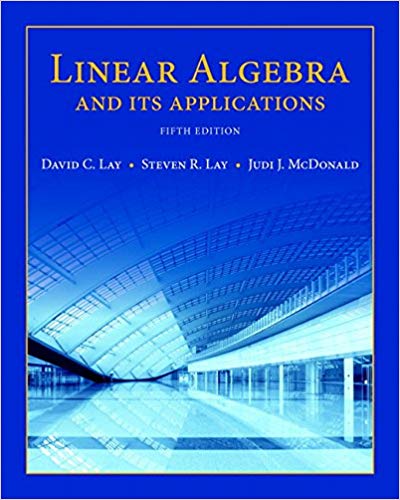
Linear Algebra and Its Applications, 5th Edition
Authors: David C. Lay, Steven R. Lay, Judi J. McDonald
ISBN-13: 978-0321982384
We have solutions for your book!
See our solution for Question 6E from Chapter 4.3 from Lay's Linear Algebra and Its Applications, 5th Edition.
Problem 6E
Chapter:
Problem:
Determine which sets in are bases for ℝ3. Of the sets that are not bases, determine which ones are linearly independent and which ones span ℝ3. Justify your answers.
Step-by-Step Solution
Given Information
We are given with following vector \[ \left[ \begin{array} { r } { 1 } \\ { 2 } \\ { - 3 } \end{array} \right] , \left[ \begin{array} { r } { - 4 } \\ { - 5 } \\ { 6 } \end{array} \right] \] We have to find whether the following vector set forms a basis or not.
Step 1:
Check if the vectors are linearly independent or not. Write the linear equation, \[\begin{array}{l} {c_1}{v_1} + {c_2}{v_2} = {\bf{0}}\\ {c_1}\left[ {\begin{array}{*{20}{c}} 1\\ 2\\ { - 3} \end{array}} \right] + {c_2}\left[ {\begin{array}{*{20}{c}} { - 4}\\ { - 5}\\ 6 \end{array}} \right] = \left[ {\begin{array}{*{20}{l}} 0\\ 0\\ 0 \end{array}} \right] \end{array}\] If above equation is satisfied by nonzero values of constants, then the vectors are linearly independent.
Step 2; System of equations
\[ \begin{aligned} c _ { 1 } - 4 c _ { 2 } & = 0 \\ 2 c _ { 1 } - 5 c _ { 2 } & = 0 \\ - 3 c _ { 1 } + 6 c _ { 2 } & = 0 \end{aligned} \] Upon solving: From first row \[ c _ { 1 } = 4 c _ { 2 } \] From second row \[ \begin{aligned} 2 \left( 4 c _ { 2 } \right) - 5 c _ { 2 } & = 0 \\ 8 c _ { 2 } - 5 c _ { 2 } & = 0 \\ 3 c _ { 2 } & = 0 \\ c _ { 2 } & = 0 \end{aligned} \] From third row \[ c _ { 1 } = 0 \] So, the solution of above system is: \[{c_1} = 0;\,\,{c_2} = 0\]
The vectors are linearly independent
Step 3: Row-Reduced augmented matrix
\[\begin{array}{l} A = \left[ {\begin{array}{*{20}{c}} 1&{ - 4}\\ 2&{ - 5}\\ { - 3}&6 \end{array}} \right]\\ = \left[ {\begin{array}{*{20}{c}} 1&{ - 4}\\ 0&3\\ 0&{ - 6} \end{array}} \right]::\,\,\left\{ \begin{array}{l} {R_2} = {R_2} - 2{R_1}\\ {R_3} = {R_3} + 3{R_1} \end{array} \right\}\\ = \left[ {\begin{array}{*{20}{c}} 1&{ - 4}\\ 0&1\\ 0&1 \end{array}} \right]::\,\,\left\{ \begin{array}{l} {R_2} = \dfrac{{{R_2}}}{3}\\ {R_2} = \dfrac{{{R_3}}}{{ - 6}} \end{array} \right\}\\ = \left[ {\begin{array}{*{20}{c}} 1&{ - 4}\\ 0&1\\ 0&0 \end{array}} \right]::\,\,\left\{ {{R_3} = {R_3} - {R_2}} \right\} \end{array}\] Since last row have all zero elements, hence
The columns do not span $R^3$
We are given with following vector \[ \left[ \begin{array} { r } { 1 } \\ { 2 } \\ { - 3 } \end{array} \right] , \left[ \begin{array} { r } { - 4 } \\ { - 5 } \\ { 6 } \end{array} \right] \] We have to find whether the following vector set forms a basis or not.
Step 1:
Check if the vectors are linearly independent or not. Write the linear equation, \[\begin{array}{l} {c_1}{v_1} + {c_2}{v_2} = {\bf{0}}\\ {c_1}\left[ {\begin{array}{*{20}{c}} 1\\ 2\\ { - 3} \end{array}} \right] + {c_2}\left[ {\begin{array}{*{20}{c}} { - 4}\\ { - 5}\\ 6 \end{array}} \right] = \left[ {\begin{array}{*{20}{l}} 0\\ 0\\ 0 \end{array}} \right] \end{array}\] If above equation is satisfied by nonzero values of constants, then the vectors are linearly independent.
Step 2; System of equations
\[ \begin{aligned} c _ { 1 } - 4 c _ { 2 } & = 0 \\ 2 c _ { 1 } - 5 c _ { 2 } & = 0 \\ - 3 c _ { 1 } + 6 c _ { 2 } & = 0 \end{aligned} \] Upon solving: From first row \[ c _ { 1 } = 4 c _ { 2 } \] From second row \[ \begin{aligned} 2 \left( 4 c _ { 2 } \right) - 5 c _ { 2 } & = 0 \\ 8 c _ { 2 } - 5 c _ { 2 } & = 0 \\ 3 c _ { 2 } & = 0 \\ c _ { 2 } & = 0 \end{aligned} \] From third row \[ c _ { 1 } = 0 \] So, the solution of above system is: \[{c_1} = 0;\,\,{c_2} = 0\]
The vectors are linearly independent
Step 3: Row-Reduced augmented matrix
\[\begin{array}{l} A = \left[ {\begin{array}{*{20}{c}} 1&{ - 4}\\ 2&{ - 5}\\ { - 3}&6 \end{array}} \right]\\ = \left[ {\begin{array}{*{20}{c}} 1&{ - 4}\\ 0&3\\ 0&{ - 6} \end{array}} \right]::\,\,\left\{ \begin{array}{l} {R_2} = {R_2} - 2{R_1}\\ {R_3} = {R_3} + 3{R_1} \end{array} \right\}\\ = \left[ {\begin{array}{*{20}{c}} 1&{ - 4}\\ 0&1\\ 0&1 \end{array}} \right]::\,\,\left\{ \begin{array}{l} {R_2} = \dfrac{{{R_2}}}{3}\\ {R_2} = \dfrac{{{R_3}}}{{ - 6}} \end{array} \right\}\\ = \left[ {\begin{array}{*{20}{c}} 1&{ - 4}\\ 0&1\\ 0&0 \end{array}} \right]::\,\,\left\{ {{R_3} = {R_3} - {R_2}} \right\} \end{array}\] Since last row have all zero elements, hence
The columns do not span $R^3$